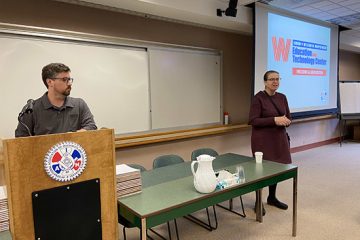IAM Canada Research Director Ivana Saula today testified in the House of Commons before the Standing Committee on Human Resources, Skills and Social Development and the Status of Persons with Disabilities studies employment, labour, income security, skills development and disability issues (HUMA).
Saula spoke to the critical topic of topic of Labour Shortages, Working Conditions and the Care Economy, which was the subject of the Committee’s meeting.
Given the representation the IAM has in the healthcare industry, this was an important subject to raise awareness around the issues in question, especially given the recent release of the IAM report on automation (authored by Saula), entitle Charting Change: Workers’ Voices in a Changing World.
The IAM’s broad recommendations are;
- That the government, federal and provincial reform labour laws to provide protections for those in non-standard and precarious employment.
- Protect the right to join a union, and make changes to union certification that match today’s labour markets
- Curb the proliferation of non-standard employment
- Work with provincial governments to promote living wages
- Conduct a thorough study of emerging trends and technologies for use in long term care (LTC)
- Include LTC into the Canada Health Act
- National strategy for health human resources in healthcare
- National standards for LTC
The MPs on the Committee asked important questions regarding the IAM report, as well as the state of everything surrounding the healthcare industry and economy, which gave the IAM ample opportunity to highlight issues affecting our members.
Saula also quoted from the IAM’s Grounded Potential, a report on the aerospace sector in Canada, which she also wrote.
The HUMA Committee is comprised of federal Members of Parliament. For a list, please visit:
https://www.ourcommons.ca/Committees/en/HUMA
Please read Ivana’s presentation below in its entirety.
—
Good morning honoured members of the Committee. My name is Ivana Saula, and I am a Research Director for the International Association of Machinists and Aerospace Workers. On behalf of the IAM and our members, I’d like to thank you for the opportunity to present our views on this important topic.
The IAM represents workers in a wide range of industries with a growing footprint in healthcare. The majority of our members in healthcare are personal support workers, nurses, and ambulance drivers working in various facilities across Ontario and Alberta, where attacks on the public sector, and healthcare in particular, have been especially aggressive.
On March 3, 2022, this Committee touched on the possibility of automation in response to labour shortages, so I will draw on conclusions from our report on automation and artificial intelligence, Charting Change, and point to a useful case study. I will also briefly comment on the governments and employers’ role in inducing labour shortages.
Employers in particular have made precarious employment and non-standard employment, which on the whole erode working conditions, the norm, rather than the exception as a feature of the labour market. An employment model that arose out of convenience for employers, has eroded work conditions across sectors, and living standards for millions of Canadians.
Personal support workers (PSW) often work for multiple employers in order to get enough hours to earn a living. This means that one employer can guarantee 4 hours per week, another, 12, and a third one 10 hours. Wages of personal support workers vary across Canada, with the starting wage in some provinces being as low as $ 12.00/hour. The work of PSWs and all healthcare workers is also characterized by physically demanding labour, workplace violence, high turnover and high rates of burnout. Not only is the work undervalued, but the framework for employment promotes instability. In some cases, PSWs work for private companies who earned record profits during the pandemic, but continue to drive wages, and other benefits down. Copious amounts of studies yield the same result; compared to workers in standard employment, those with non-standard jobs tend to have lower wages, lower job tenure, higher poverty rates, less education and fewer workplace benefits, like pensions. Similarly, poverty rates of workers in non-standard employment are two to three times higher than the poverty rates of workers in standard employment.
Demand for care work in healthcare is expected to continue increasing, and according to the U.S. Bureau of Statistics, personal support workers and home care workers are expected to be two of the fastest growing occupations over the next ten years. If these jobs are in demand, and proven to be critical to our economy, why are workers in this sector not adequately compensated? Our members find this work meaningful and are proud of what they do; it’s not the work itself that makes recruitment difficult, rather, recruitment is challenging because of low wages, and lack of recognition.
Japan serves as an excellent case study of the impact of labour shortages on the healthcare system. Labour shortages are especially acute in retirement homes and long-term care, where the elderly are looking after the elderly. Japan’s response to this issue has been automation, making Japan’s use of robots fourth highest in the world. The use of exo-skeletons, interactive robots and piloting culturally sensitive robots are becoming the norm as the country anticipates severe labour shortages coupled with growing demand for workers in long-term care. Given the immediate need for labour, it seems that an understanding of the impact of automation on quality of care has not been sufficiently studied.
In North America, vast amounts of resources are funnelled into studying and developing devices that replace the need for human assistance, such as, automated health assessment systems, in-home monitoring systems, smart assistive walking devices, biosensors to name a few. These technologies would directly impact personal support workers, healthcare aides and other ancillary staff. But, technological developments in healthcare go beyond assistive devices. Take for instance, RoBear, a miniaturized personal robot aide capable of responding to emotional expressions, it speaks with an ability to convey intonation that ranges from happiness to sympathy. Its eyes transmit video, the belly is a two-way communication screen, it can assist with patient lifting and transfer, takes x-rays and digital pictures it then shares with specialists and doctors. As smart technologies become more sophisticated, smart residencies will be made possible, making it possible for people to age at home, in turn reducing reliance on homecare staff.
While it’s possible to address the gap in labour needs through technology, we have yet to fully understand the impact on elderly and aging clients, their quality of care, and quality of life. Technology may be convenient, but we should not turn to this as a solution without a full understanding of its impact on the healthcare system, patients and clients.
———————-
This article was originally posted on the IAM Canada website. View the original post here: IAM presents key information to Parliamentary Committee on the health economy


